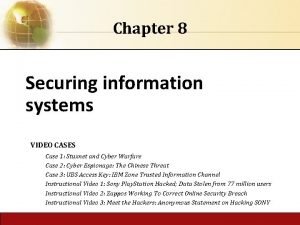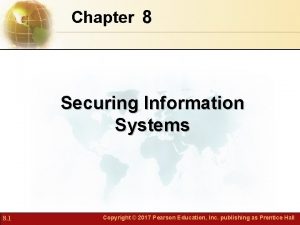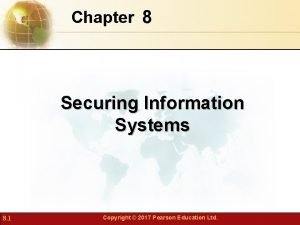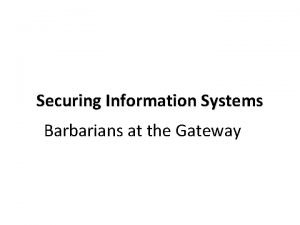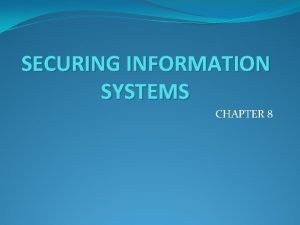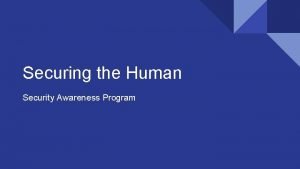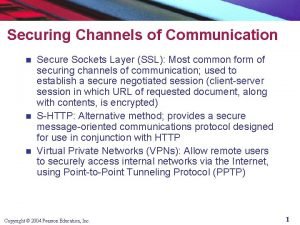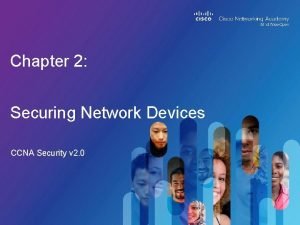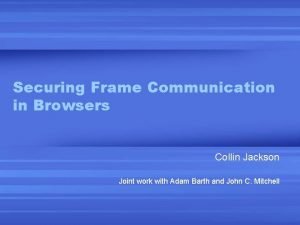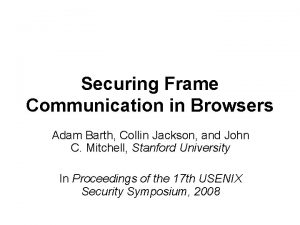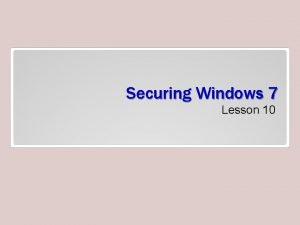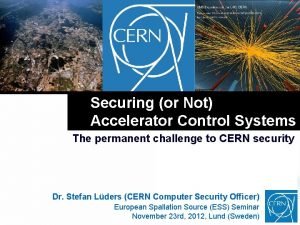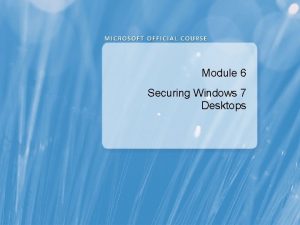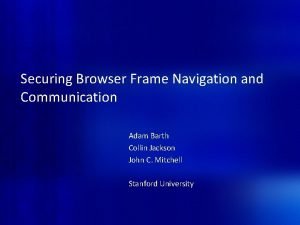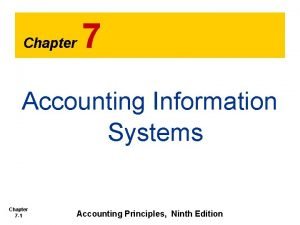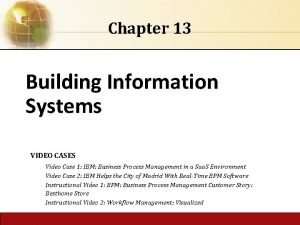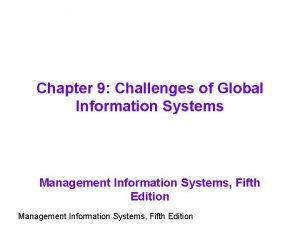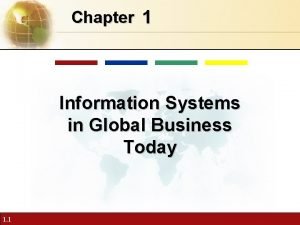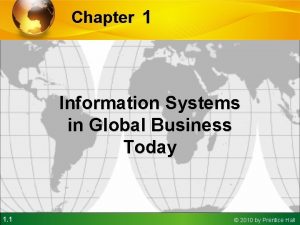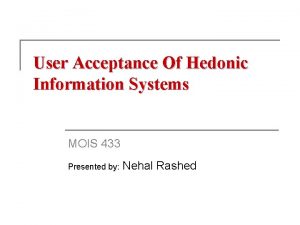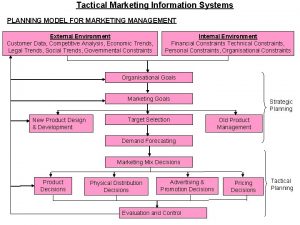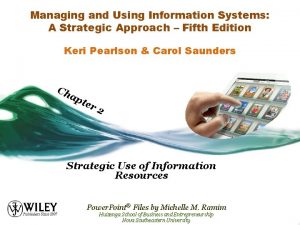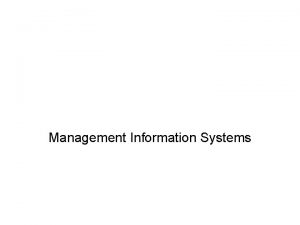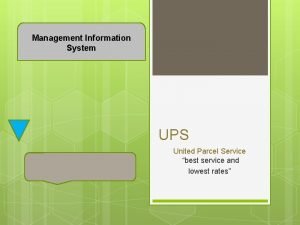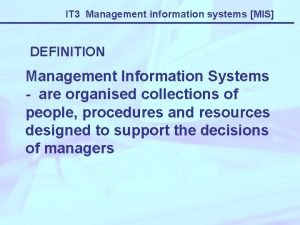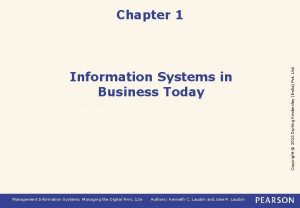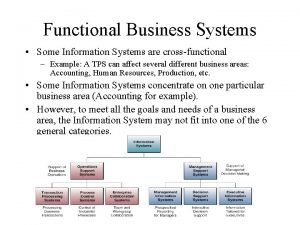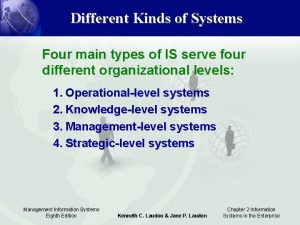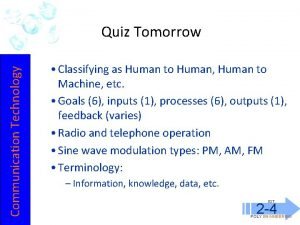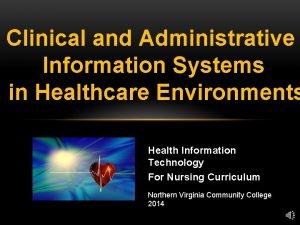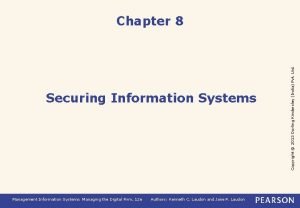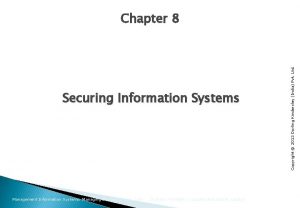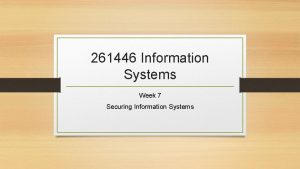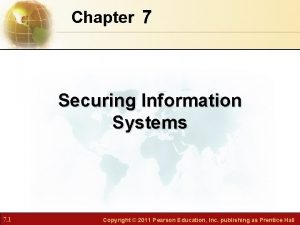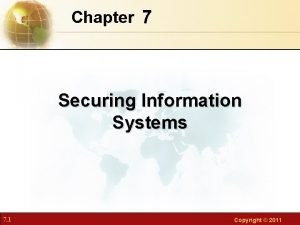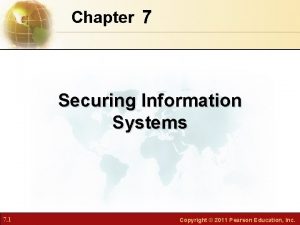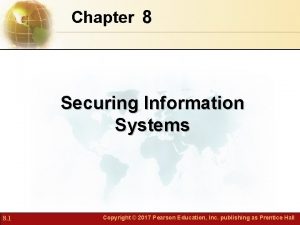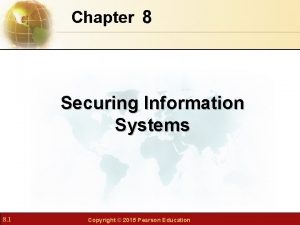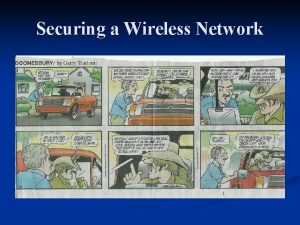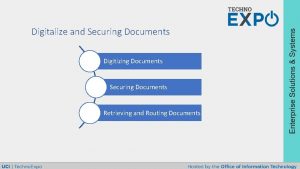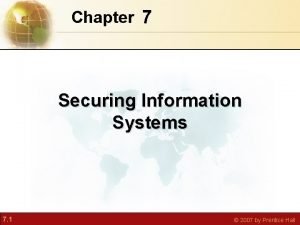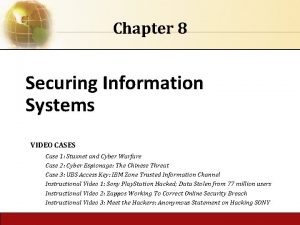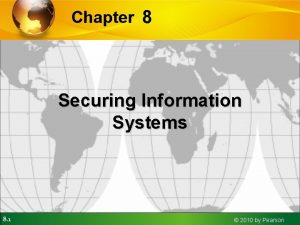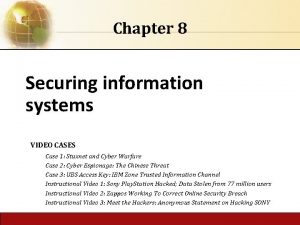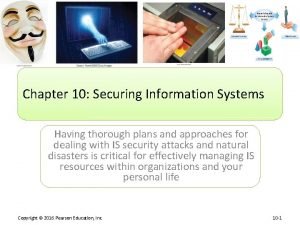Chapter 8 Securing Information Systems 8 1 Copyright






















































- Slides: 54

Chapter 8 Securing Information Systems 8. 1 Copyright © 2017 Pearson Education, Inc. publishing as Prentice Hall

Essentials of Management Information Systems Chapter 8 Securing Information Systems STUDENT LEARNING OBJECTIVES • Why are information systems vulnerable to destruction, error, and abuse? • What is the business value of security and control? • What are the components of an organizational framework for security and control? • What are the important tools and technologies for safeguarding information resources? 8. 2 Copyright © 2017 Pearson Education, Inc. publishing as Prentice Hall

Essentials of Management Information Systems Chapter 7 Telecommunications, the Internet, and Wireless Technology Student Support Materials Learning Tracks 1. 2. 3. 4. 5. 6. The Booming Job Market in IT Security The Sarbanes Oxley Act Computer Forensics General and Application Controls for Information Systems Management Challenges of Security and Control Software Vulnerability and Reliability Video Cases Case 1: Stuxnet and Cyberwarfare Case 2: Cyberespionage: The Chinese Threat Case 3: IBM Zone Trusted Information Channel (ZTIC) Instructional Video 1: Sony Play. Station Hacked; Data Stolen from 77 Million Users Instructional Video 2: Zappos Working to Correct Online Security Breach Instructional Video 3: Meet the Hackers: Anonymous Statement on Hacking SONY 8. 3 Copyright © 2017 Pearson Education, Inc. publishing as Prentice Hall

Essentials of Management Information Systems Chapter 8 Securing Information Systems Target Becomes the Target For Massive Data Theft • Target – 2 nd largest retailer in the US, 1797 stores – $72 billion in revenue • Problem – – – 8. 4 Outdated security processes Hackers targeted payment systems and credit cards Single point of entry: HVAC company 40 million customers data breached Reputational damage. Lost sales. 70 law suits Estimated total loss of $18 billion for all parties Copyright © 2017 Pearson Education, Inc. publishing as Prentice Hall

Essentials of Management Information Systems Chapter 8 Securing Information Systems Target Becomes the Target For Massive Data Theft • Solutions • White-listing of Web traffic access • Segregation of data and systems, eliminate single point of entry • Change to “smart card” technology so hackers can’t use stolen data • Demonstrates need for updating security policies continuously 8. 5 Copyright © 2017 Pearson Education, Inc. publishing as Prentice Hall

Essentials of Management Information Systems Chapter 8 Securing Information Systems Target Becomes the Target For Massive Data Theft 8. 6 Copyright © 2017 Pearson Education, Inc. publishing as Prentice Hall

Essentials of Management Information Systems Chapter 8 Securing Information Systems Why Are Information Systems Vulnerable? • An unprotected computer connected to Internet may be disabled within seconds • Security: • Policies, procedures, and technical measures used to prevent unauthorized access, alteration, theft, or physical damage to information systems • Controls: • Methods, policies, and organizational procedures that ensure safety of organization’s assets; accuracy and reliability of its accounting records; and operational adherence to management standards 8. 7 Copyright © 2017 Pearson Education, Inc. publishing as Prentice Hall

Essentials of Management Information Systems Chapter 8 Securing Information Systems Why Are Information Systems Vulnerable? Why Systems Are Vulnerable • Hardware problems • Breakdowns, configuration errors, damage from improper use or crime • Software problems • Programming errors, installation errors, unauthorized changes • Disasters • Power failures, flood, fires, and so on • Use of networks, computers outside of firm’s control • Domestic or offshore outsourcing vendors • Mobile devices 8. 8 Copyright © 2017 Pearson Education, Inc. publishing as Prentice Hall

Essentials of Management Information Systems Chapter 8 Securing Information Systems Why Are Information Systems Vulnerable? Contemporary Security Challenges and Vulnerabilities Figure 8. 1 The architecture of a Web-based application typically includes a Web client, a server, and corporate information systems linked to databases. Each of these components presents security challenges and vulnerabilities. Floods, fires, power failures, and other electrical problems can cause disruptions at any point in the network. 8. 9 Copyright © 2017 Pearson Education, Inc. publishing as Prentice Hall

Essentials of Management Information Systems Chapter 8 Securing Information Systems Why Are Information Systems Vulnerable? • Internet vulnerabilities • Network open to anyone • Size of Internet means abuses can have wide impact • Use of fixed Internet addresses with permanent connections to Internet eases identification by hackers • E-mail attachments, file downloading and sharing • E-mail used for transmitting trade secrets • IM messages lack security, can be easily intercepted 8. 10 Copyright © 2017 Pearson Education, Inc. publishing as Prentice Hall

Essentials of Management Information Systems Chapter 8 Securing Information Systems Why Are Information Systems Vulnerable? • Wireless security challenges • Radio frequency bands easy to scan • SSIDs (service set identifiers) • Identify access points. • Broadcast multiple times. • War driving • Eavesdroppers drive by buildings and try to intercept network traffic • With access to SSID, has access to network’s resources • Rogue access points 8. 11 Copyright © 2017 Pearson Education, Inc. publishing as Prentice Hall

Essentials of Management Information Systems Chapter 8 Securing Information Systems Why Are Information Systems Vulnerable? Wi-Fi Security Challenges Figure 8. 2 Many Wi-Fi networks can be penetrated easily by intruders using sniffer programs to obtain an address to access the resources of a network without authorization. 8. 12 Copyright © 2017 Pearson Education, Inc. publishing as Prentice Hall

Essentials of Management Information Systems Chapter 8 Securing Information Systems Why Are Information Systems Vulnerable? Malicious Software: Viruses, Worms, Trojan Horses, and Spyware • Malware • Viruses • Rogue software program that attaches itself to other software programs or data files in order to be executed • Worms • Independent computer programs that copy themselves from one computer to other computers over a network • Trojan horses • Software program that appears to be benign but then does something other than expected. 8. 13 Copyright © 2017 Pearson Education, Inc. publishing as Prentice Hall

Essentials of Management Information Systems Chapter 8 Securing Information Systems Why Are Information Systems Vulnerable? Malicious Software: Viruses, Worms, Trojan Horses, and Spyware • SQL injection attacks • Spyware • Small programs install themselves surreptitiously on computers to monitor user Web surfing activity and serve up advertising • Key loggers • Record every keystroke on computer to steal serial numbers, passwords, launch Internet attacks 8. 14 Copyright © 2017 Pearson Education, Inc. publishing as Prentice Hall

Essentials of Management Information Systems Chapter 8 Securing Information Systems Why Are Information Systems Vulnerable? Hackers and Computer Crime • Hackers versus crackers • Activities include: • System intrusion • Theft of goods and services • System damage • Cybervandalism — Intentional disruption, defacement, destruction of Web site or corporate information system 8. 15 Copyright © 2017 Pearson Education, Inc. publishing as Prentice Hall

Essentials of Management Information Systems Chapter 8 Securing Information Systems Why Are Information Systems Vulnerable? Hackers and Computer Crime • Spoofing • Misrepresenting oneself by using fake e-mail addresses or masquerading as someone else • Redirecting Web link to address different from intended one, with site masquerading as intended destination • Sniffer • Eavesdropping program that monitors information traveling over network • Enables hackers to steal proprietary information such as email, company files, and so on 8. 16 Copyright © 2017 Pearson Education, Inc. publishing as Prentice Hall

Essentials of Management Information Systems Chapter 8 Securing Information Systems Why Are Information Systems Vulnerable? Hackers and Computer Crime • Denial-of-service attacks (Do. S) • Flooding server with thousands of false requests to crash the network. • Distributed denial-of-service attacks (DDo. S) • Use of numerous computers to launch a Do. S • Botnets • Networks of “zombie” PCs infiltrated by bot malware 8. 17 Copyright © 2017 Pearson Education, Inc. publishing as Prentice Hall

Essentials of Management Information Systems Chapter 8 Securing Information Systems Why Are Information Systems Vulnerable? Hackers and Computer Crime • Computer crime • Any violations of criminal law that involve a knowledge of computer technology for their perpetration, investigation, or prosecution • Computer may be target of crime: • Breaching confidentiality of protected computerized data • Accessing a computer system without authority • Computer may be instrument of crime: • Theft of trade secrets • Using e-mail for threats or harassment 8. 18 Copyright © 2017 Pearson Education, Inc. publishing as Prentice Hall

Essentials of Management Information Systems Chapter 8 Securing Information Systems Why Are Information Systems Vulnerable? Hackers and Computer Crime • Identity theft • Theft of personal information (social security id, driver’s license, or credit card numbers) to impersonate someone else • Phishing • Setting up fake Web sites or sending e-mail messages that look like legitimate businesses to ask users for confidential personal data • Evil twins • Wireless networks that pretend to offer trustworthy Wi-Fi connections to the Internet 8. 19 Copyright © 2017 Pearson Education, Inc. publishing as Prentice Hall

Essentials of Management Information Systems Chapter 8 Securing Information Systems Why Are Information Systems Vulnerable? Hackers and Computer Crime • Pharming • Redirects users to a bogus Web page, even when individual types correct Web page address into his or her browser • Click fraud • Fraudulent clicks on online ads • Global threats • Cyberterrorism • Cyberwarfare 8. 20 Copyright © 2017 Pearson Education, Inc. publishing as Prentice Hall

Essentials of Management Information Systems Chapter 8 Securing Information Systems Why Are Information Systems Vulnerable? Internal Threats: Employees • Security threats often originate inside an organization. • Inside knowledge • Sloppy security procedures • User lack of knowledge • Social engineering: • Tricking employees into revealing their passwords by pretending to be legitimate members of the company in need of information 8. 21 Copyright © 2017 Pearson Education, Inc. publishing as Prentice Hall

Essentials of Management Information Systems Chapter 8 Securing Information Systems Why Are Information Systems Vulnerable? Software Vulnerability • Commercial software contains flaws that create security vulnerabilities. • Hidden bugs (program code defects) • Zero defects cannot be achieved because complete testing is not possible with large programs • Flaws can open networks to intruders • Zero-day Vulnerabilities • Can’t protect against malware you don’t know about • Surprise: there’s new malware everyday • Anti-malware and virus programs always behind 8. 22 Copyright © 2017 Pearson Education, Inc. publishing as Prentice Hall

Essentials of Management Information Systems Chapter 8 Securing Information Systems Why Are Information Systems Vulnerable? • Patches: Small pieces of software to repair flaws released by vendors • However, amount of software in use, and shear number of malware programs, can mean exploits are created faster than patches can be released 8. 23 • Large number of software applications • Disparate operating systems • Poor management of patches Copyright © 2017 Pearson Education, Inc. publishing as Prentice Hall

Essentials of Management Information Systems Chapter 8 Securing Information Systems What is the Business Value of Security and Control? • Failed computer systems can lead to significant or total loss of business function. • Firms now more vulnerable than ever. • A security breach may cut into firm’s market value almost immediately. • Inadequate security and controls also bring forth issues of liability. 8. 24 Copyright © 2017 Pearson Education, Inc. publishing as Prentice Hall

Essentials of Management Information Systems Chapter 8 Securing Information Systems Business Value of Security and Control Legal and Regulatory Requirements for Electronic Records Management • Firms face new legal obligations for the retention and storage of electronic records as well as for privacy protection • HIPAA: medical security and privacy rules and procedures • Gramm-Leach-Bliley Act: requires financial institutions to ensure the security and confidentiality of customer data • Sarbanes-Oxley Act: imposes responsibility on companies and their management to safeguard the accuracy and integrity of financial information that is used internally and released externally 8. 25 Copyright © 2017 Pearson Education, Inc. publishing as Prentice Hall

Essentials of Management Information Systems Chapter 8 Securing Information Systems Business Value of Security and Control Electronic Evidence and Computer Forensics • Evidence for white collar crimes often found in digital form • Data stored on computer devices, e-mail, instant messages, ecommerce transactions • Proper control of data can save time, money when responding to legal discovery request • Computer forensics: • Scientific collection, examination, authentication, preservation, and analysis of data from computer storage media for use as evidence in court of law • Includes recovery of ambient and hidden data 8. 26 Copyright © 2017 Pearson Education, Inc. publishing as Prentice Hall

Essentials of Management Information Systems Chapter 8 Securing Information Systems What are the components of an organizational framework for security and control? • Information systems controls • General controls • Govern design, security, and use of computer programs and security of data files in general throughout organization’s information technology infrastructure. • Apply to all computerized applications. • Combination of hardware, software, and manual procedures to create overall control environment. 8. 27 Copyright © 2017 Pearson Education, Inc. publishing as Prentice Hall

Essentials of Management Information Systems Chapter 8 Securing Information Systems Components of an organizational framework for security and control • Types of general controls • Software controls • Hardware controls • Computer operations controls • Data security controls • Implementation controls • Administrative controls 8. 28 Copyright © 2017 Pearson Education, Inc. publishing as Prentice Hall

Essentials of Management Information Systems Chapter 8 Securing Information Systems Components of an organizational framework for security and control • Application controls • Specific controls unique to each computerized application, such as payroll or order processing. • Include both automated and manual procedures. • Ensure that only authorized data are completely and accurately processed by that application. • Include: • Input controls • Processing controls • Output controls 8. 29 Copyright © 2017 Pearson Education, Inc. publishing as Prentice Hall

Essentials of Management Information Systems Chapter 8 Securing Information Systems Components of an organizational framework for security and control • Risk assessment • Determines level of risk to firm if specific activity or process is not properly controlled • • 8. 30 Types of threat Probability of occurrence during year Potential losses, value of threat Expected annual loss EXPOSURE PROBABILITY LOSS RANGE EXPECTED ANNUAL LOSS Power failure 30% $5 K - $200 K $30, 750 Embezzlement 5% $1 K - $50 K $1, 275 User error 98% $200 - $40 K $19, 698 Copyright © 2017 Pearson Education, Inc. publishing as Prentice Hall

Essentials of Management Information Systems Chapter 8 Securing Information Systems The Flash Crash: A New Culprit Interactive Session: People The Flash Crash: A New Culprit Read the Interactive Session and answer the following questions: • Identify the problem and the control weaknesses described in this case. • What people, organization, and technology factors contributed to this problem? To what extent was it a technology problem? To what extent was it a people and organizational problem? • To what extent was Sarao responsible? Explain your answer. • Is there an effective solution to this problem? Can another flash crash be prevented? Explain your answer. 8. 31 Copyright © 2017 Pearson Education, Inc. publishing as Prentice Hall

Essentials of Management Information Systems Chapter 8 Securing Information Systems Components of an organizational framework for security and control • Security policy • Ranks information risks • Identifies acceptable security goals • Identifies mechanisms for achieving these goals • Drives other policies • Acceptable use policy (AUP) • Authorization policies • Provisions for identity management 8. 32 Copyright © 2017 Pearson Education, Inc. publishing as Prentice Hall

Essentials of Management Information Systems Chapter 8 Securing Information Systems Components of an organizational framework for security and control • Identity management • Business process and technologies for identifying valid users of system • Creates different levels or roles of system user and access • Allows each user access only to those portions of system that user role 8. 33 Copyright © 2017 Pearson Education, Inc. publishing as Prentice Hall

Essentials of Management Information Systems Chapter 8 Securing Information Systems Components of an organizational framework for security and control Security Profiles for a Personnel System Figure 8. 3 These two examples represent two security profiles or data security patterns that might be found in a personnel system. Depending on the security profile, a user would have certain restrictions on access to various systems, locations, or data in an organization. 8. 34 Copyright © 2017 Pearson Education, Inc. publishing as Prentice Hall

Essentials of Management Information Systems Chapter 8 Securing Information Systems Components of an organizational framework for security and control Disaster Recovery Planning and Business Continuity Planning • Disaster recovery planning: Devises plans for restoration of disrupted services • Business continuity planning: Focuses on restoring business operations after disaster • Both types of plans needed to identify firm’s most critical systems • Business impact analysis to determine impact of an outage • Management must determine which systems restored first 8. 35 Copyright © 2017 Pearson Education, Inc. publishing as Prentice Hall

Essentials of Management Information Systems Chapter 8 Securing Information Systems Components of an organizational framework for security and control The Role of Auditing • MIS audit • Examines firm’s overall security environment as well as controls governing individual information systems • Reviews technologies, procedures, documentation, training, and personnel • May even simulate disaster to test response of technology, IS staff, other employees • Lists and ranks all control weaknesses and estimates probability of their occurrence. • Assesses financial and organizational impact of each threat 8. 36 Copyright © 2017 Pearson Education, Inc. publishing as Prentice Hall

Essentials of Management Information Systems Chapter 8 Securing Information Systems What are the most important tools and technologies for safeguarding information resources? Sample Auditor’s List of Control Weaknesses Figure 8. 4 This chart is a sample page from a list of control weaknesses that an auditor might find in a loan system in a local commercial bank. This form helps auditors record and evaluate control weaknesses and shows the results of discussing those weaknesses with management, as well as any corrective actions taken by management. 8. 37 Copyright © 2017 Pearson Education, Inc. publishing as Prentice Hall

Essentials of Management Information Systems Chapter 8 Securing Information Systems Most important tools and technologies for safeguarding information resources Identity Management and Authentication • Authentication • Password systems • Tokens • Smart cards • Biometric authentication • Fingerprints, irises, voices 8. 38 Copyright © 2017 Pearson Education, Inc. publishing as Prentice Hall

Essentials of Management Information Systems Chapter 8 Securing Information Systems Most important tools and technologies for safeguarding information resources Firewalls, Intrusion Detection Systems, and Antivirus Software • Firewall: • Combination of hardware and software that prevents unauthorized access to network • Technologies include: • Packet filtering • Stateful inspection • Network address translation (NAT) • Application proxy filtering 8. 39 Copyright © 2017 Pearson Education, Inc. publishing as Prentice Hall

Essentials of Management Information Systems Chapter 8 Securing Information Systems Most important tools and technologies for safeguarding information resources A Corporate Firewall Figure 8. 5 The firewall is placed between the firm’s private network and the public Internet or another distrusted network to protect against unauthorized traffic. 8. 40 Copyright © 2017 Pearson Education, Inc. publishing as Prentice Hall

Essentials of Management Information Systems Chapter 8 Securing Information Systems Most important tools and technologies for safeguarding information resources • Intrusion detection systems: • Monitor hot spots on corporate networks to detect and deter intruders. • Examine events as they are happening to discover attacks in progress. • Antivirus and antispyware software: • Check computers for presence of malware and can often eliminate it as well. • Require continual updating. • Unified Threat Management (UTM) systems 8. 41 Copyright © 2017 Pearson Education, Inc. publishing as Prentice Hall

Essentials of Management Information Systems Chapter 8 Securing Information Systems Most important tools and technologies for safeguarding information resources Securing Wireless Networks • WEP security can be improved: • Activating it • Assigning unique name to network’s SSID • Using it with VPN technology • Wi-Fi Alliance finalized WPA 2 specification, replacing WEP with stronger standards • Continually changing keys • Encrypted authentication system with central server 8. 42 Copyright © 2017 Pearson Education, Inc. publishing as Prentice Hall

Essentials of Management Information Systems Chapter 8 Securing Information Systems Most important tools and technologies for safeguarding information resources Encryption and Public Key Infrastructure • Encryption: • Transforming text or data into cipher text that cannot be read by unintended recipients • Two methods for encryption on networks • Secure Sockets Layer (SSL) and successor Transport Layer Security (TLS) • Secure Hypertext Transfer Protocol (S-HTTP) 8. 43 Copyright © 2017 Pearson Education, Inc. publishing as Prentice Hall

Essentials of Management Information Systems Chapter 8 Securing Information Systems Most important tools and technologies for safeguarding information resources Encryption and Public Key Infrastructure • Two methods of encryption • Symmetric key encryption • Sender and receiver use single, shared key • Public key encryption • Uses two, mathematically related keys: public key and private key • Sender encrypts message with recipient’s public key • Recipient decrypts with private key 8. 44 Copyright © 2017 Pearson Education, Inc. publishing as Prentice Hall

Essentials of Management Information Systems Chapter 8 Securing Information Systems Most important tools and technologies for safeguarding information resources Public Key Encryption A public key encryption system can be viewed as a series of public and private keys that lock data when they are transmitted and unlock the data when they are received. The sender locates the recipient’s public key in a directory and uses it to encrypt a message. The message is sent in encrypted form over the Internet or a private network. When the encrypted message arrives, the recipient uses his or her private key to decrypt the data and read the message. Figure 8. 6 8. 45 Copyright © 2017 Pearson Education, Inc. publishing as Prentice Hall

Essentials of Management Information Systems Chapter 8 Securing Information Systems Most important tools and technologies for safeguarding information resources • Digital certificate: • Data file used to establish the identity of users and electronic assets for protection of online transactions • Uses certification authority (CA) to validate a user’s identity • CA verifies user’s identity, stores information in CA server, which generates encrypted digital certificate containing owner ID information and copy of owner’s public key • Public key infrastructure (PKI) • Use of public key cryptography working with certificate authority • Widely used in e-commerce 8. 46 Copyright © 2017 Pearson Education, Inc. publishing as Prentice Hall

Essentials of Management Information Systems Chapter 8 Securing Information Systems Most important tools and technologies for safeguarding information resources Digital Certificates Figure 8. 7 Digital certificates help establish the identity of people or electronic assets. They protect online transactions by providing secure, encrypted, online communication. 8. 47 Copyright © 2017 Pearson Education, Inc. publishing as Prentice Hall

Essentials of Management Information Systems Chapter 8 Securing Information Systems Most important tools and technologies for safeguarding information resources Ensuring System Availability • Online transaction processing requires 100 percent availability, no downtime. • Fault-tolerant computer systems • For continuous availability, e. g. , stock markets • Contain redundant hardware, software, and power supply components that create an environment that provides continuous, uninterrupted service • High-availability computing • Helps recover quickly from crash • Minimizes, does not eliminate, downtime 8. 48 Copyright © 2017 Pearson Education, Inc. publishing as Prentice Hall

Essentials of Management Information Systems Chapter 8 Securing Information Systems Most important tools and technologies for safeguarding information resources Ensuring System Availability • Recovery-oriented computing • Designing systems that recover quickly with capabilities to help operators pinpoint and correct faults in multicomponent systems • Controlling network traffic • Deep packet inspection (DPI) (video and music blocking) • Security outsourcing • Managed security service providers (MSSPs) 8. 49 Copyright © 2017 Pearson Education, Inc. publishing as Prentice Hall

Essentials of Management Information Systems Chapter 8 Securing Information Systems Most important tools and technologies for safeguarding information resources Security Issues for Cloud Computing • Cloud computing • Highly distributed computing, difficult to track unauthorized activities • Cloud users should ask for proof of security and privacy procedures, including encryption • Service level agreements (SLAs) 8. 50 Copyright © 2017 Pearson Education, Inc. publishing as Prentice Hall

Essentials of Management Information Systems Chapter 8 Securing Information Systems Most important tools and technologies for safeguarding information resources Security Issues for the Mobile Digital Platform • Mobile platforms • Mobile device management tools for authorization and inventory • Data loss prevention technology • Mobile security policies: platform, software, procedures, security products • Encryption • BYOD • Mobile protective software products 8. 51 Copyright © 2017 Pearson Education, Inc. publishing as Prentice Hall

Essentials of Management Information Systems Chapter 8 Securing Information Systems Most important tools and technologies for safeguarding information resources Interactive Session: Technology BYOD: It’s Not So Safe • Read the Interactive Session and then discuss the following questions: • • 8. 52 It has been said that a smartphone is “a microcomputer in your hand. ” Discuss the security implications of this statement. What people, organizational, and technology issues must be addressed by smartphone security? What problems do smartphone security weaknesses cause for businesses? What steps can individuals and businesses take to make their smartphones more secure? Copyright © 2017 Pearson Education, Inc. publishing as Prentice Hall

Essentials of Management Information Systems Chapter 8 Securing Information Systems Most important tools and technologies for safeguarding information resources Ensuring Software Quality • Software Metrics: objective assessments of system in form of quantified measurements, e. g. : • Number of transactions • Online response time • Payroll checks printed per hour • Known bugs per hundred lines of code • Early and regular testing • Walkthrough: review of specification or design document by small group of qualified people • Debugging: process by which errors are eliminated 8. 53 Copyright © 2017 Pearson Education, Inc. publishing as Prentice Hall

All rights reserved. No part of this publication may be reproduced, stored in a retrieval system, or transmitted, in any form or by any means, electronic, mechanical, photocopying, recording, or otherwise, without the prior written permission of the publisher. Printed in the United States of America. 8. 54 Copyright © 2017 Pearson Education, Inc. publishing as Prentice Hall
 Chapter 8 securing information systems
Chapter 8 securing information systems Chapter 8 securing information systems
Chapter 8 securing information systems Chapter 8 securing information systems
Chapter 8 securing information systems Chapter 8 securing information systems
Chapter 8 securing information systems Chapter 8 securing information systems
Chapter 8 securing information systems Securing information system
Securing information system An information systems examines a firm's overall security
An information systems examines a firm's overall security Chapter 8 securing the republic summary
Chapter 8 securing the republic summary Securing the human
Securing the human The most common form of securing channel through
The most common form of securing channel through Defence in depth
Defence in depth Securing frame communication in browsers
Securing frame communication in browsers Securing frame communication in browsers
Securing frame communication in browsers Securing windows 7
Securing windows 7 Securing
Securing Securing windows 7
Securing windows 7 Shampoo drape
Shampoo drape Securing the northwest territory
Securing the northwest territory Adam secure browser
Adam secure browser Mis chapter 1
Mis chapter 1 Chapter 7 accounting information systems
Chapter 7 accounting information systems Chapter 7 accounting information systems
Chapter 7 accounting information systems Chapter 13 building information systems
Chapter 13 building information systems White-collar workers คือ
White-collar workers คือ Fundamentals of information system
Fundamentals of information system Global challenges in information system
Global challenges in information system Chapter 4 ethical issues
Chapter 4 ethical issues Information systems in global business today
Information systems in global business today Introduction to mis
Introduction to mis Chapter 4 ethical and social issues in information systems
Chapter 4 ethical and social issues in information systems Chapter 7 accounting information systems
Chapter 7 accounting information systems Chapter 3 information systems organizations and strategy
Chapter 3 information systems organizations and strategy Information system in global business
Information system in global business Decision support systems and intelligent systems
Decision support systems and intelligent systems Principles of complex systems for systems engineering
Principles of complex systems for systems engineering Embedded systems vs cyber physical systems
Embedded systems vs cyber physical systems Elegant systems
Elegant systems User acceptance of hedonic information systems
User acceptance of hedonic information systems Tactical marketing information systems
Tactical marketing information systems Retail management upc
Retail management upc Principles of information security, 7th edition
Principles of information security, 7th edition Managing and using information systems
Managing and using information systems Management information system topics
Management information system topics Tactical management information system
Tactical management information system What strategic business objectives do ups’s
What strategic business objectives do ups’s Components of mis
Components of mis Objective of a business firm?
Objective of a business firm? Introduction to information systems 6th edition
Introduction to information systems 6th edition Fundamentals of information systems 9th edition
Fundamentals of information systems 9th edition Fundamentals of information systems 9th edition
Fundamentals of information systems 9th edition Cross functional information system
Cross functional information system Ethics in mis
Ethics in mis Types of information systems
Types of information systems Communication technology quiz
Communication technology quiz What is administrative information systems in healthcare
What is administrative information systems in healthcare


